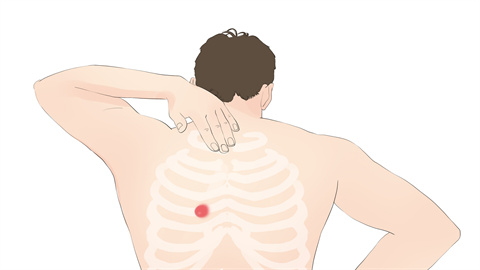What causes a hard lump on the back, and what should I do?
Generally, hard lumps on the back may be caused by skin keratinization, fat accumulation, folliculitis, furuncles, cellulitis, or other reasons. Treatment options include general care and medication therapy, under a doctor's guidance. If discomfort symptoms occur, please seek medical attention promptly for relevant examinations and treatment. Detailed analysis is as follows:

1. Skin Keratinization
Skin keratinization is a normal physiological phenomenon caused by excessive proliferation of the stratum corneum, which may result in hard lumps on the back. It is recommended to maintain skin cleanliness and avoid excessive friction and squeezing of the back skin; use mild bathing products and avoid harsh chemicals.
2. Fat Accumulation
Excessive fat accumulation on the back may form localized fatty masses with a hard texture. Maintain a healthy diet and reduce intake of high-calorie, high-fat foods. Increase physical exercise, especially exercises targeting the back muscles, such as swimming and yoga.
3. Folliculitis
Folliculitis is mainly caused by pathogens such as bacteria and fungi infecting hair follicles. Common causative agents include Staphylococcus aureus and Malassezia. Bacterial invasion of hair follicles causes an inflammatory response, resulting in red, swollen, painful hard lumps. Mild itching and pain may also be present. Patients may use medications such as erythromycin ointment, mupirocin ointment, or clarithromycin tablets as directed by a physician.
4. Furuncle
Furuncles are commonly caused by Staphylococcus aureus infection and may develop from the merging of multiple boils. After hair follicle infection, surrounding tissues develop purulent inflammation, forming hard lumps. Symptoms such as fever and chills may also occur. Under medical guidance, patients may use medications such as mupirocin ointment, fusidic acid cream, or sustained-release cefaclor tablets for treatment.
5. Cellulitis
Cellulitis is an acute diffuse suppurative infection of subcutaneous, subfascial, intermuscular, or deep connective tissues, commonly caused by hemolytic streptococci, Staphylococcus aureus, and others. The inflammation spreads rapidly, and the affected tissue feels hard with unclear borders, resulting in the aforementioned symptoms. Chills and headache may also appear. Patients may use medications such as ofloxacin gel, penicillin V potassium tablets, or Ruyijinhuang powder as advised by a doctor.
Maintain good personal hygiene in daily life: bathe regularly, change clothes frequently, especially areas prone to sweating such as the back, and keep the skin clean and dry.









